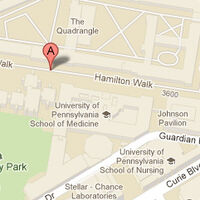Gold Lab Projects
Locus Coeruleus and Pupil Diameter
The locus coerulus (LC) is a small brainstem nucleus that is the primary source of norepinephrine (NE) to the cortex, thalamus, midbrain, cerebellum, and spinal cord. The LC-NE system is thought to play important roles in many normal brain functions, including arousal and sensory-motor processing. In addition, the LC-NE system has been implicated in a number of clinical disorders, including attention-deficit/hyperactivity disorder (ADHD), anxiety, depression, and schizophrenia. Thus, a better understanding of the properties of the LC-NE system is likely to provide important insights into both normal and abnormal brain function.
Experiments to assess LC function directly are severely limited by its size and location. In my laboratory we now record regularly from LC neurons as part of our ongoing efforts to understand the contribution of the LC-NE system to sensory, motor, and cognitive processes. However, these experiments provide a low yield: typically <5 neurons/week. Attempts to image LC in humans are underway elsewhere, but this approach is technically difficult, expensive, and even if successful will be limited by a lack of understanding of how LC firing properties relate to the BOLD signal.
Given these limitations, a complementary, non-invasive method to measure LC activity would be a major breakthrough in our ability to understand both basic and translational aspects of LC function. One tantalizing possibility is pupil diameter, which is relatively inexpensive and straightforward to measure and is thought to reflect LC activation under certain constant-light conditions. However, the mostly indirect evidence that supports the existence of this relationship falls far short of making it useful. Is the relationship between LC activation and pupil diameter strong and/or reliable enough to allow measurements of pupil diameter to be used as a proxy for LC activation? Does the reliability of this relationship depend on the particular conditions, such as ambient luminance, LC firing properties, or behavioral context?
Ongoing work in our laboratory is designed to provide a rigorous and quantitative examination of the relationship between LC activation and pupil diameter under a variety of conditions, to provide answers to these questions and allow the widespread measurements of pupil diameter to be more effectively interpreted in relation to LC function.
Close
Belief Updating in Dynamic Environments
Maintaining appropriate beliefs about variables needed for effective decision-making can be difficult in a dynamic environment. One key issue is the amount of influence that unexpected outcomes should have on existing beliefs. In general, outcomes that are unexpected because of a fundamental change in the environment should carry more influence than outcomes that are unexpected because of persistent environmental stochasticity. We have developed novel tasks to study how human and non-human subjects follow these principles under a range of conditions. We have found that the brain adaptively regulates the influence of decision outcomes on existing beliefs using straightforward updating rules that take into account both recent outcomes and prior expectations about higher-order environmental structure.
Close
Perceptual Learning
Perceptual decisions require the brain to weigh noisy evidence from sensory neurons to form categorical judgments that guide behavior. We have shown that at least some forms of perceptual learning do not appear to affect the response properties of neurons that represent the sensory evidence. Instead, improved perceptual performance results from changes in how the sensory evidence is selected and weighed to form the decision. Ongoing projects are examining in further detail the neural mechanisms responsible for these experience-dependent changes in decision formation.
Close
Complex Decision-Making
Everyday behaviors are often driven by a complex interplay between external visual cues and internal desires, aversions, and idiosyncratic biases. For example, catching a baseball requires following its trajectory in flight but also suppressing a fear of getting hit by it. Ordering a meal at a restaurant depends on personal food preference but can also be biased by the sights (and smells) of other meals being served nearby. Despite recent progress in our understanding of how the brain interprets visual inputs to form perceptual decisions and how the brain uses outcome expectations to form value-based decisions, it remains unclear how the brain coordinates these processes. The goal of this project is to establish and characterize the central role played by the basal ganglia (BG), an interconnected network of subcortical brain regions implicated in learning, valuation, and action selection, in coordinating visual and non-sensory factors to guide oculomotor behavior.
We are also developing new theoretical and modeling approaches to better define, understand, and make use of the idea of complexity itself. These approaches are based on the idea that formal definitions of complexity from physics, computer science, and other fields can help us make sense of the specific strategies that individual decision-makers use to solve various tasks.
Close
Relevant code on GitHub is here.


